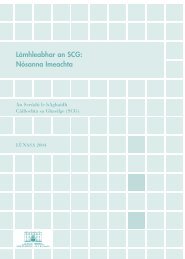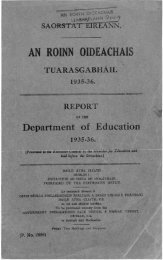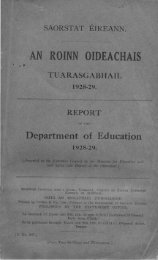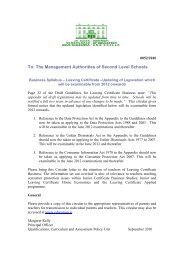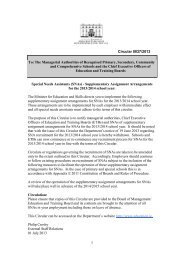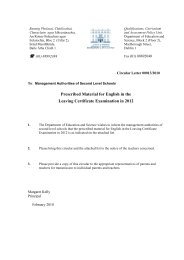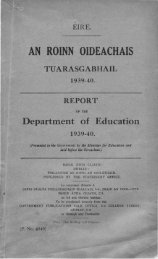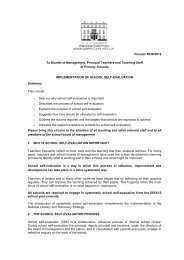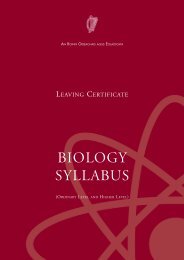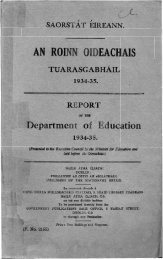1925-1926-1927 - Department of Education and Skills
1925-1926-1927 - Department of Education and Skills
1925-1926-1927 - Department of Education and Skills
- No tags were found...
Create successful ePaper yourself
Turn your PDF publications into a flip-book with our unique Google optimized e-Paper software.
35tended to decline considerably. Parents <strong>and</strong> pupils appear toregard the Act as implying that a pupil's primary educationshould be completed at fourteen, <strong>and</strong> that there is no furtherobligation to attend school, no matter what st<strong>and</strong>ard <strong>of</strong> pr<strong>of</strong>iciencythe pupil has reached. Perhaps a stronger reason is thatthe older pupils are more required at home for assistance in farmwork since pupils between eleven <strong>and</strong> fourteen cannot be so employedfor irregular periods. The increasing dem<strong>and</strong> for secondaryeducation also tends to diminish the number <strong>of</strong> older pupilsin the Primary Schools. It is worth noting, ho-wever,that duringthe two years or so prior to the introduction <strong>of</strong> compulsory attendancethere was an improvement in the attendance in many<strong>of</strong> our schools. This was to some degree attributable to the Americanimmigration regulations forbidding the entrance <strong>of</strong>illiterates.'I'he increased attendance in our schools has considerably accentuatedthe question <strong>of</strong> adequate accommodation. Many buildingsthat were formerly adequate for requirements arc now overcrowded,white schools that were already congested are now dangerouslyso.The question <strong>of</strong> the repair <strong>and</strong> upkeep <strong>of</strong> school buildings isone that calls for serious consideration. Where the schoolhousesare not kept in due repair, the buildings have a comparativelyshort life; <strong>and</strong> the original state grants are to a large extentwasted. Some managers in poor western districts have as manyas ten or twelve schools under their care, <strong>and</strong> the cost <strong>of</strong> theirupkeep in a storm-swept country is very serious.In my last report I commented on the lack <strong>of</strong> taste apparentin the manner in which the interior <strong>and</strong> surroundings <strong>of</strong> too many<strong>of</strong> our schools are kept. On the other h<strong>and</strong>, however, there is aconsiderable section <strong>of</strong> OUl' teachers who keep their school-rooms<strong>and</strong> the school surroundings in a tasteful <strong>and</strong> becoming manner,that cannot fail to have a. definite cultural influence 011 theirpupils. But it is exceedingly infrequent to find our school wallsadorned with copies <strong>of</strong> good pictures, <strong>and</strong> as copies <strong>of</strong> famousmasterpieces can now be obtained cheaply, it is a pity that a few<strong>of</strong> them do not find a place in the wall decoration scheme <strong>of</strong>every school.'I'he front plots <strong>of</strong> a number <strong>of</strong> schools have nicely kept flowerbeds, aud in some cases rose bushes '0J' creepers arc trained alongth e school wall. But I should like to see flowers grown aroundour schools to a much greater extent than is the case at present.There are only a few cases <strong>of</strong> schools provided with plots suitablefor practical work in connection with the rural science programme.School libraries are practically non-existent, but large numbers<strong>of</strong> teachers avail themselves <strong>of</strong> the facilities provided hy ·heCounty Library Scheme in County Galway, <strong>and</strong> get supplies <strong>of</strong>,



